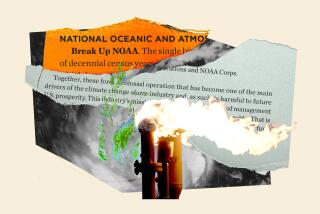Arctic Ozone Layer Called ‘Primed’ for Depletion : Scientists Find ‘Incredible’ Level of Chemicals Imperiling Polar Atmosphere
- Share via
WASHINGTON — In a finding with ominous environmental implications, government scientists warned Friday that man-made pollutants have left the atmosphere above the Arctic “primed” for significant destruction of the ozone layer.
The researchers, reporting on the first extensive survey of the Arctic atmosphere since threats to the ozone layer emerged as a worldwide concern, said they had found “incredible” concentrations of chemicals in the stratosphere near the North Pole capable of destroying ozone there at a rate of up to 1% a day.
Weather conditions will determine the rate at which ozone actually will be destroyed, the scientists said. The atmospheric chemicals--byproducts of man-made chlorofluorocarbons--must be activated by sunlight to destroy ozone and will prove most devastating if polar winds do not disperse them before seasonal change brings more daylight to the Arctic.
“The atmosphere is primed for a large destruction of ozone,” said Robert Watson, who headed the Arctic expedition for the National Aeronautics and Space Administration. “Whether it will occur or not depends effectively on how the atmosphere behaves in the next few weeks.”
The discovery of what Watson called the “amazing potential” for ozone destruction in the Arctic adds another troubling element to knowledge about the threat to the protective ozone layer, a part of the stratosphere that shields the Earth from harmful ultraviolet rays.
A mere 1% depletion in the ozone layer increases ultraviolet penetration by 2% and adds 4% to 5% to the risk of skin cancer, scientists believe.
Worldwide concern about the ozone layer reached a level of urgency in 1985, when British scientists discovered that gradual ozone depletion had caused a “hole” to appear in the ozone layer over Antarctica each spring. Scientists blamed the devastation on the widespread use of synthetic CFCs--widely used in refrigerators and air conditioners and for the production of plastic insulating foam.
The anxieties were compounded last spring by the disclosure that the ozone layer over parts of the Northern Hemisphere had been depleted since 1969 by as much as 6%--and by about 2.3% over much of the United States. In an update, Canadian scientists reported this week that ozone depletion over parts of the Arctic had become so serious that it could be considered equivalent to the Antarctic hole.
U.S. scientists Friday declined to support the Canadians’ contention, saying that such a judgment is premature. But they stressed that their discovery of high concentrations of chlorine compounds in the Arctic stratosphere--in quantities up to 50 times greater than would occur naturally--provides ominous evidence of potential symmetry between the two polar regions.
Accumulate in Clouds
In the Arctic as in the Antarctic, they found, chlorine-containing molecules from the CFCs accumulate on the ice in stratospheric clouds, which are found only at the poles. When sunlight strikes the molecules, the reaction on the cloud surface destroys ozone much faster than reactions elsewhere in the stratosphere.
Many scientists previously had believed that the colder weather and unusual meteorological characteristics over Antarctica made the rapid rate of ozone destruction there unique.
The scientists said that ozone destruction in the Arctic this year has probably just begun because daylight has only recently returned to the atmosphere there. The extent of depletion will largely depend on the date at which a “vortex” formed by polar winds begins its seasonal movement and disperses the concentrations of harmful chemicals. In most years, that process begins within two weeks of the onset of daylight.
For that reason, the scientists provided no assessment of ozone destruction in the Arctic to date and declined to estimate the extent of ultimate ozone depletion.
‘Strong Lesson’
The scientists said that the surprising discovery of extreme chlorine concentrations had added significantly to their concerns about the future of the ozone layer and stressed that their report should be interpreted as a “strong lesson to the policy-makers.”
They noted that the Montreal Protocol, an international agreement among 46 nations requiring a 50% worldwide reduction in CFC production by the end of the century, was enacted because of fears raised by the discovery of the ozone hole over Antarctica.
“There’s no question that the buildup of these . . . compounds is an additional ozone depleting process,” said Adrian Tucker, project scientist for the National Oceanographic and Atmospheric Administration.
Expect Chemicals to Double
“Clearly,” Watson said, “the Montreal Protocol ought to be revisited.” Even if every nation agreed to the treaty, he said, levels of chlorine and another ozone-destroying chemical, bromine, would double in the next 20 years because CFCs currently in the atmosphere are slow to decompose and CFCs stored in existing products such as refrigerators and air conditioners will not be released until the products are junked. Such a doubling of CFC prevalence would compound the threat to the ozone layer by a factor of four.
Environmentalists voiced agreement with the call for a new emphasis on a complete CFC phase-out and urged the Bush Administration to make its position clear before April, when the parties to the Montreal Protocol are to gather to reassess the treaty.
“It’s a major part of the puzzle,” said Rafe Pomerance of the World Resources Institute. “We’re approaching the Helsinki meeting, and we don’t even have a position.”
Manufacturers of CFCs have begun to phase out production of the chemical products even more quickly than required under the treaty. This week, the Food Service and Packaging Institute announced that it had accomplished a complete elimination of CFCs from American food packaging products. Recently, the Polyurethane Foam Assn. announced plans to phase out CFCs in foam cushioning.
Still Used as Coolants
But there has been less action in finding a substitute for CFCs used as coolants, which are a major source of the polluting chemicals.
A spokesman for the Alliance for Responsible CFC Policy, a coalition of manufacturers, said Friday that the group supports efforts to strengthen the Montreal Protocol. But he stressed that reductions of CFC production must be achieved on an international basis, and said: “We still need to ensure that we have some type of substitute for existing products.”
The U.S. scientific expedition, led by NASA and NOAA, spent six weeks in the Arctic, flying a modified U-2 spy plane and a DC-8 flying laboratory from a base in Norway into the atmosphere high above the North Pole.
Study of the Arctic atmosphere was given high priority because of the relatively large population that could be affected by ozone depletion in the northern regions. The study is continuing and researchers should be able to monitor arctic cloud conditions over the next several weeks to determine the rate at which ozone is being destroyed.
More to Read
Sign up for Essential California
The most important California stories and recommendations in your inbox every morning.
You may occasionally receive promotional content from the Los Angeles Times.













